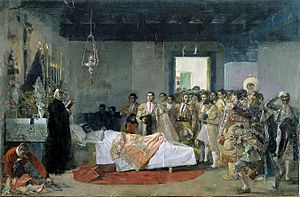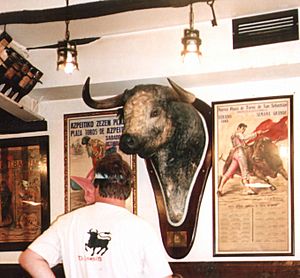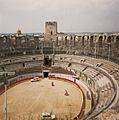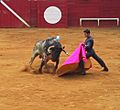Bullfighting facts for kids
Bullfighting is a very old sport, mostly popular today in Spain, Portugal, and some countries in South America.
The biggest bullring is the Plaza México in Mexico City, which can hold 48,000 people. The oldest is La Maestranza in Seville, Spain, first used for bullfighting in 1765.
The Spanish bullfight, called a Corrida de toros, is a traditional event. It follows a special set of rules and has three main parts. Each part begins with a trumpet signal. The bullfighters, known as Toreros, enter the arena in a parade while Paso doble music plays. The rules, costumes, and traditions were largely set by a famous matador named Paquiro (Francisco Montes Reina), who lived from 1804 to 1851.
A team of bullfighters has seven men. The main bullfighter is called the matador. He has six helpers who play different roles in the event. Bullfighters' costumes are inspired by old 18th-century clothes from Andalusia. Matadores (which means 'those who kill the bull') are easy to spot because their special suit, called a traje de luces ('suit of lights'), is gold.
The final part of the bullfight is called the tercio de muerte ('the third of death'). The matador comes back into the ring alone. He carries a small red cape called a muleta and a sword. The matador uses his cape to guide the bull through a series of moves. This performance with the cape is called the faena. The faena ends with the matador trying to get the bull into a certain position. He then uses his sword to try and end the fight.
Sometimes, if the matador makes a mistake, the bull's horns can injure him. This has happened, and some famous matadors have even died in the ring. When a great matador named Manolete was killed at age 31, the country held three days of official mourning. Bullrings usually have a special room, like a small hospital, with an operating room. This is for treating bullfighters right away if they get hurt by a horn.
Many animal welfare groups are against bullfighting. There are also types of bullfights where the animal is not harmed.
Bullfighting in Culture
Bullfighting has had a big impact on many kinds of art and culture. Ernest Hemingway, a famous writer, once said that bullfighting is special because the artist (the bullfighter) is in danger of death. He also said that how well the bullfighter performs depends on their honor. Spanish dances and music, like the paso doble and flamenco, are very much influenced by the excitement of the bullfight.
Dangers in the Ring

Spanish-style bullfighting often results in the bull's death. It is also dangerous for the matador. Matadors are often injured by the bull's horns each season. Other bullfighters, like picadors and banderilleros, are injured less often. Thanks to new medicines and better surgery, deaths are now rare. However, over the last 300 years, 534 professional bullfighters have died in the ring or from their injuries. Most recently, Iván Fandiño died on June 17, 2017, after being gored by a bull in France.
Some matadors, like Juan Belmonte, were seriously gored many times. According to Ernest Hemingway, Belmonte's legs had many scars. A special kind of surgeon has developed in Spain and other places just to treat cornadas, which are horn-wounds.
Bullrings usually have a small chapel where a matador can pray before the corrida. A priest is also available in case a special prayer or blessing is needed. This is now called "Anointing of the Sick".
News often reports the more serious bullfighting injuries. For example, in September 2011, matador Juan José Padilla was gored in the head by a bull in Zaragoza. He lost his left eye, couldn't use his right ear well, and had facial paralysis. He returned to bullfighting five months later with an eyepatch. He also had metal plates in his skull and was nicknamed 'The Pirate'.
Until the early 1900s, the horses used in bullfights were not protected and were often killed. These horses were usually old and not worth much. After the 1900s, horses started to be protected by thick blankets. Injuries to horses still happened, but they were less common and less serious.
However, danger can come from other things besides the bull. Sometimes, the buildings themselves can be unsafe. In 2022, in Colombia, several people died and over 300 were hurt when a stand collapsed during a bullfight. This happened in El Espinal, Tolima, in central Colombia.
Images for kids
-
Bull-leaping: Fresco from Knossos, Crete
-
Monument to a bull, Plaza de Toros de Ronda (Ronda bullring), Spain
-
Death of the Picador – Francisco de Goya, c. 1793
-
Goya: The Speed and Daring of Juanito Apiñani in the Ring of Madrid 1815–16 (Tauromaquia, Νο. 20). Etching and aquatint
-
Poster by Cândido de Faria for the silent film Course de taureaux à Séville (1907, Pathé Frères). Chromolithograph. EYE Film Institute Netherlands.
-
The Roman amphitheater at Arles being fitted for a corrida
-
A youth trying to take control of a bull at a Jallikattu in Tamil Nadu, India
-
In California, the lances are tipped with hook and loop fasteners (e.g. Velcro) and aimed at pads on the bull.
-
A matador evading a bull in Cancún, Mexico. 2012.
-
Bullfighting statue at Shilpacharya Zainul Abedin Folk Arts and Crafts Museum, Bangladesh
See also
 In Spanish: Tauromaquia para niños
In Spanish: Tauromaquia para niños























